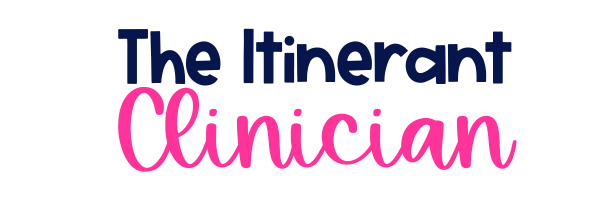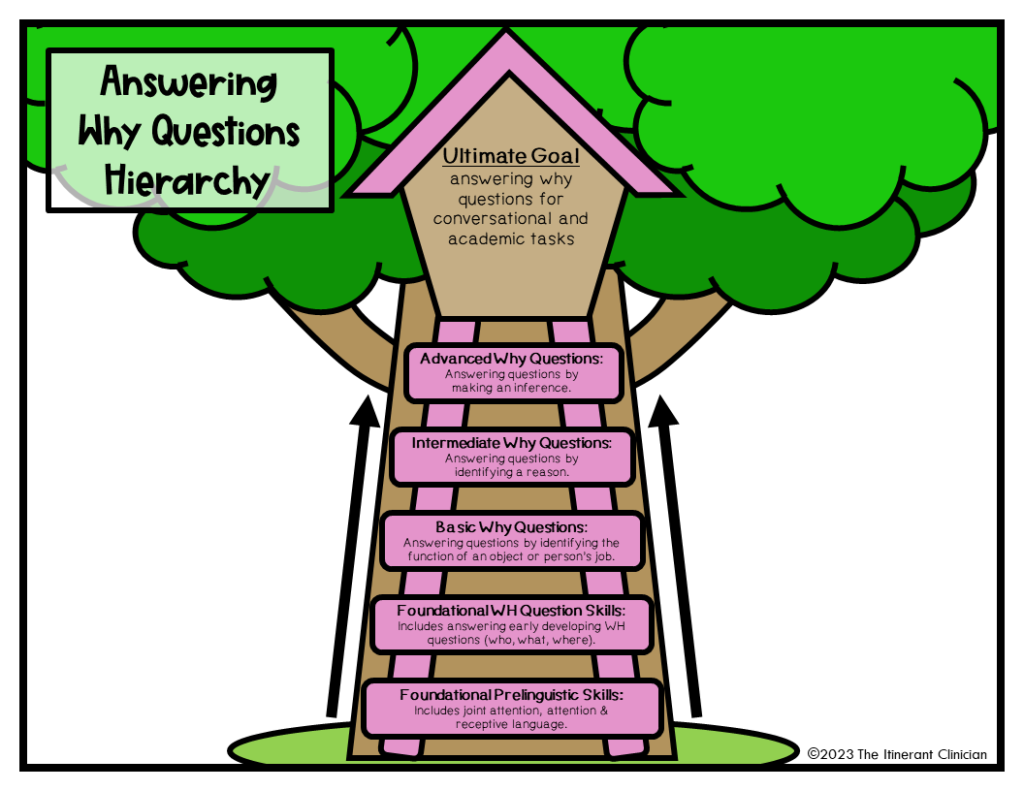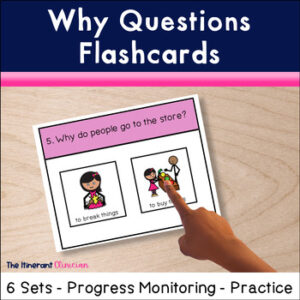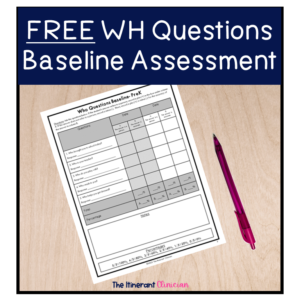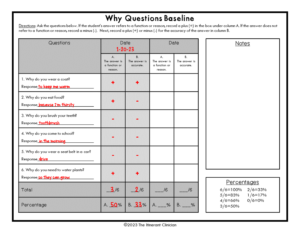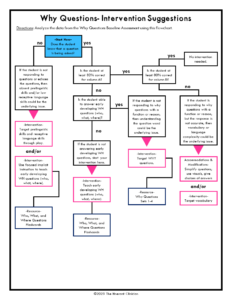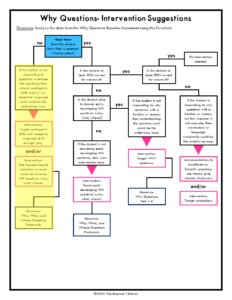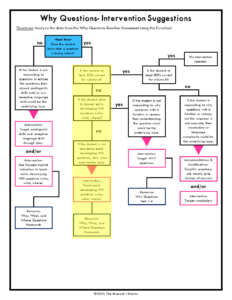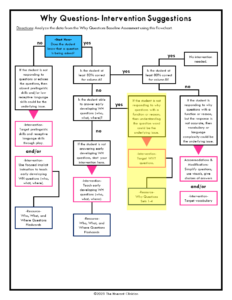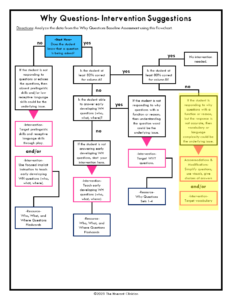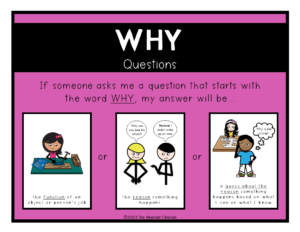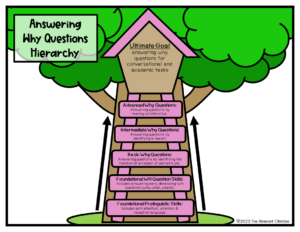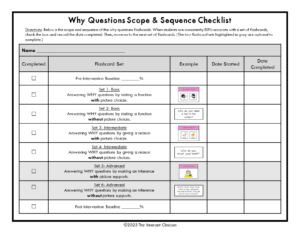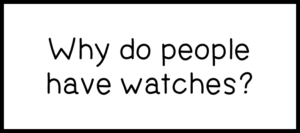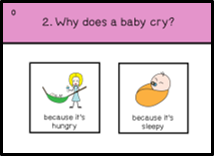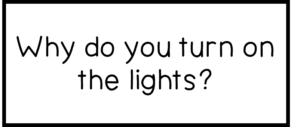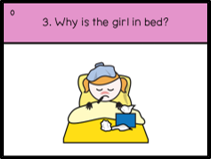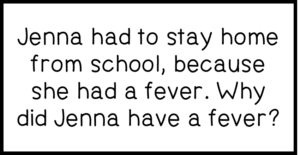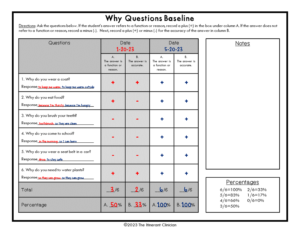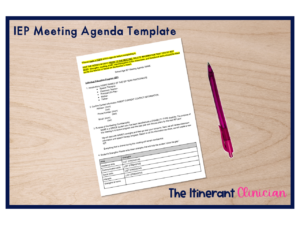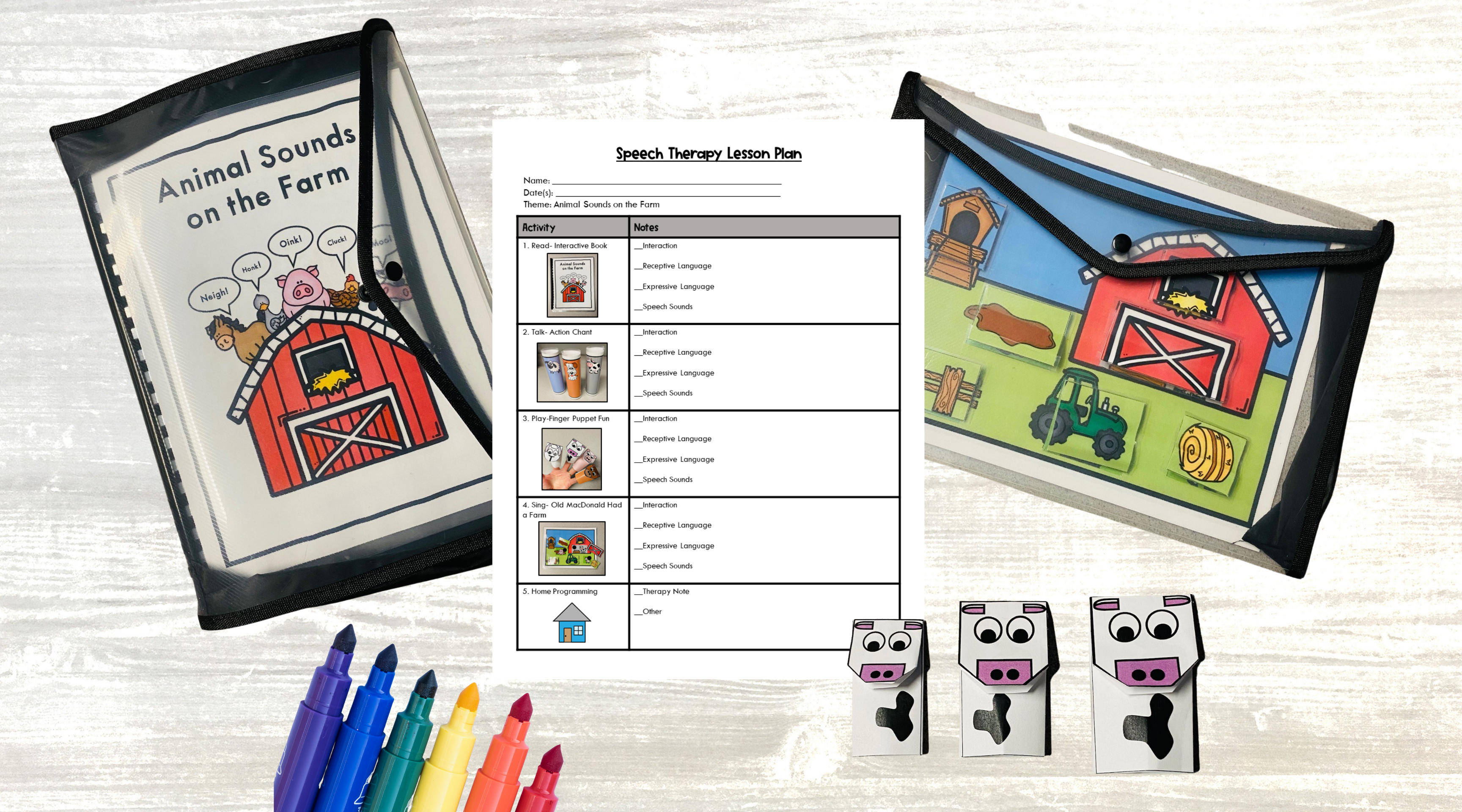Sharing is caring!
Teaching why questions for speech therapy intervention can be a challenge, especially when there is never enough time in your day to plan effective therapy. I’m here to simplify your therapy by giving you an easy-to-follow plan when it comes to teaching why questions.
After reading this post, you will have a structured speech therapy intervention plan for teaching why questions for speech therapy that you can implement tomorrow. Here is an overview of the 5 steps that will make you the expert at your school when it comes to writing and addressing those why question IEP goals.
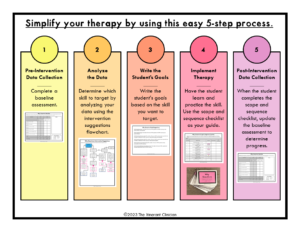
- Step 1: Start with pre-intervention data collection for why questions for speech therapy.
- Step 2: Analyze the data from Step 1 to determine where to start your intervention.
- Step 3: Using the information from Step 2, write your student’s speech therapy goals.
- Step 4: Implement therapy.
- Step 5: Complete your post-intervention data collection.
Note: This easy 5-step process is included in my Why Questions Flashcards resource. If you would like to skip the rest of this article and jump right into your intervention, click the picture below.
Step 1. Start with pre-intervention data collection for why questions.
Determining IEP goals and planning speech therapy intervention depends upon knowing how the student is currently performing with a specific skill. Using an informal WH question test for data collection in speech therapy is a must.
If you don’t have a data collection tool for WH or why questions for speech therapy, don’t worry. Download my FREE WH Questions Baseline Assessment today!
Here is a completed why questions baseline from my wh questions for speech therapy resource.
Step 2. Analyze the data from Step 1 to determine where to start your intervention.
Knowing where to start why questions for speech therapy intervention can sometimes be tricky. After completing the baseline assessment from step 1, use this free flow chart to help you analyze your data. This will help you determine your therapy plan.
If you would like a free copy of this flow chart, click on the image above and print.
There are four columns on the flow chart. Here is what each column means.
- Left Column: Focus on teaching prelinguistic skills and building receptive language.
- Left Middle Column: Work on teaching early developing WH questions- who, what, where.
- Right Middle Column: Work on teaching why questions.
- Right Column: Work on increasing vocabulary. Making IEP accommodations might also be appropriate.
Step 3. Using the information from Step 2, write your student’s speech therapy goals.
First, keep in mind normal why question development.
For planning why question speech therapy goals, it is important to keep in mind normal why question development. Here are the norms that I use from the resource Guide to Communication Milestones (Lanza, J. R. & Flahive, L. K., 2012).
Why Question Development
- Answers WHY questions about the functions of objects (i.e., Why do we have eyes?): 3-4 years of age.
- Answers more complex WHY questions logically: 3-4 years of age.
Keep in mind that this norm is most likely referring to simple why questions that don’t require detailed explanations.
Then, determine a starting point for speech therapy intervention.
Using the flow chart from step 2, while keeping in mind normal why question development, determine your IEP goals.
Left Column: Focus on prelinguistic goals and receptive language goals. If your student is on this side of the flow chart, you should not be introducing why questions.
Prelinguistic Goal for Joint Attention: The student will demonstrate joint attention in 8/10 trials why the adult points to/shows an object or talks about an immediate event (something that is happening in the child’s present environment).
Click here for more information on joint attention.
Prelinguistic Goal for Attending: The student will attend to a reading and/or play activity for ___ minutes with minimal adult support in 4/5 trials.
Receptive Language Goal for WH Questions (Play Based): The student will respond to WHO, WHAT, and/or WHERE questions during a play activity in 8/10 trials by pointing.
Early Developing WH Questions Goal (Skill Based): The student will answer basic WHO, WHAT, and/or WHERE questions by pointing to or stating the answer with 80% accuracy. (i.e., Where is your nose? What is this?)
Left Middle Column: Focus on teaching early developing wh questions- who, what, where. After these questions are mastered, move on to why questions for speech therapy.
WHO Questions Speech Therapy Goal: The student will answer WHO questions with 80% accuracy when picture choices are presented.
WHO Questions Speech Therapy Goal: The student will answer WHO questions with 80% accuracy. (no picture choices)
WHAT Questions Speech Therapy Goal: The student will answer WHAT questions with 80% accuracy when picture choices are presented.
WHAT Questions Speech Therapy Goal: The student will answer WHAT questions with 80% accuracy. (no picture choices)
WHERE Questions Goal: The student will answer WHERE questions with 80% accuracy when picture choices are presented.
WHERE Questions Goal: The student will answer WHERE questions with 80% accuracy. (no picture choices)
Right Middle Column: Focus on teaching why questions.
Although you can get very detailed with your IEP goals, I recommend keeping things simple. It’s important that other team members understand the student’s goals. Here are two simple why questions example goals.
WHY Questions Speech Therapy Goal: The student will answer WHY questions with 80% accuracy when picture choices are presented.
WHY Questions Speech Therapy Goal: The student will answer WHY questions with 80% accuracy. (no picture choices)
If your student is working on inferencing skills, as well as answering why questions, here are some suggestions.
WHY Questions Speech Therapy Making Inferences Goal: The student will answer WHY questions that require him/her to make an inference with 80% accuracy when picture scenes are presented.
WHY Questions Making Inferences Speech Therapy Goal: The student will answer WHY questions that require him/her to make an inference with 80% accuracy without picture supports.
If your student is working on generalizing why questions to conversational and reading comprehension tasks, these are some suggestions.
WHY Questions Conversational Goal: The student will answer WHY questions during conversation with 80% accuracy.
WHY Questions Reading Comprehension Goal: The student will answer WHY questions for reading comprehension tasks with 80% accuracy.
Right Column: Increasing vocabulary to support answering why questions might be the best course of treatment. Considering IEP accommodations for addressing language complexity might also be appropriate.
You might find that it is more appropriate to focus on accommodations and modifications to decrease the barriers that might exist when answering questions. Here is a list of possible accommodations and modifications.
- Simplify questions by decreasing the amount of complex language used in the question.
- Supplement your verbal question with a picture scene or picture cue.
- Give the student visual or verbal choices of answers.
Step 4. Implement therapy.
Now that you have your student’s IEP goals written, it’s time to get your speech therapy intervention tools ready. You might already have a resource that works well for addressing why question goals. However, if you are looking for a more comprehensive resource for teaching why questions, I have created a set of why questions flashcards that you can purchase. The materials and flashcards featured in this section are from that resource.
First, teach the skill.
Explicit Instruction
Consider starting with explicit instruction when teaching a student to answer why questions. This is how I begin each session. There is research in the area of grammar intervention that suggests combining explicit instruction with implicit instruction is more efficient than just implicit instruction alone. (Calder, S.D., Claessen, M., Ebbels, S. & Leitao, S., 2020)
Directly teach your students that when they hear the word why in a question it refers to the function of an object or person’s job or the reason that something happens.
Then, practice the skill.
There isn’t much research that I’ve come across in regards to a hierarchy for how to teach why questions. The following is based on my clinical experience and what I’ve found to be effective in teaching why questions for speech therapy intervention. Although this learning ladder provides a general hierarchy, you should always consider the student’s language profile when planning intervention.
Note: I only practice why questions with elementary-age students (5K+). Why questions require higher level language skills to answer because the questions/answers require more abstract thinking than early developing WH questions (who, what, where).
Here is the scope and sequence of my why questions flashcard resource.
If the student is old enough, I use flashcards between turns of an open-ended game. The game motivates students to participate in a flashcard activity that would otherwise be a non preferred task.
1. Basic Why Questions for Speech Therapy
Start with basic why questions. (These WH question examples are from sets 1-2 of my why questions flashcards resource.) If your student can already answer basic why questions, move on to intermediate why questions.
WH Question Examples: Why do you have eyes? Why does a school need teachers?
Prerequisite Skills: The student needs to understand the functions of objects or peoples’ jobs.
First, I start by using flashcards with picture choices. Before moving on to the next set of cards, I might use these cards again but not show the picture choices. If the student has difficulty answering the question, I show the picture choices.
Although the research is mixed on the efficacy of using picture choices to teach questions, I find that pictures minimize frustration with teaching why questions. It is a perfect strategy for students who need to take baby steps when learning a new skill.
Then, I move on to flashcards without picture choices.
2. Intermediate Why Questions for Speech Therapy
Next, address why questions that require the student to state a reason. (These WH question examples are from sets 3-4 of my why questions flashcards resource.)
WH Question Examples: Why do you have to take a shower? Why do you go to school?
Prerequisite Skills: The student needs to understand the reasons why we demonstrate certain behaviors or why things happen in the natural world.
First, I start by using flashcards with picture choices.
Then, I use the same flashcards but don’t show the picture choices. If the student gets stuck with answering the question, I show the picture choices.
Finally, I move on to flashcards without picture choices.
3. Advanced Why Questions for Speech Therapy
Finally, I work on advanced why questions. This level is optional and I don’t address these with all of my students. These questions are perfect for students who are working on inferencing skills and answering why questions at the same time. (This WH question example is from sets 5-6 of the why questions flashcards resource.)
WH Question Example: Jenna had to stay home from school because she had a fever. Why did Jenna have a fever?
Prerequisite Skills: The student needs to be able to use clues (things he/she observes) mixed with prior knowledge to make a guess about why something is happening.
First, I use flashcards with picture supports.
Then, I move on to flashcards without picture supports.
Step 5. Complete your post-intervention data collection.
When your session data suggests that the student has learned how to answer why questions, update the original baseline assessment. This provides you with data to report at the IEP meeting and/or on the progress report. If the student has met his or her goal, move on to the next skill.
What is the ultimate goal for working on why questions for speech therapy?
It is important to note that during this process of teaching why questions for speech therapy, it’s essential to incorporate why questions into conversational and read-aloud activities. This is the overarching goal of working on questions- to be able to participate in a conversation and answer questions for academic tasks.
If you are unsure of your student’s accuracy with answering WH and why questions, get a free baseline tool. This will help you determine where you should start with intervention.
Wondering where you can get the WH question examples featured in this post? Get your own set of why question flashcards to complement your therapy at my Teachers Pay Teachers store.
Other Related Posts:
4 Things To Consider Before Writing Speech Therapy WH Question Goals
5 Steps for Effectively Teaching Who Questions for Speech Therapy
How to Teach What Questions in Speech Therapy
5 Simple Steps for Teaching Where Questions for Speech Therapy
5 Easy Steps for Teaching When Questions for Speech Therapy
Resources:
Calder, S.D., Claessen, M., Ebbels, S., & Leitão, S. (2020). Explicit grammar intervention in young school-aged children with developmental language disorder: An efficacy study using single-case experimental design. Language, Speech, and Hearing Services in Schools. https://doi.org/10.1044/2019_LSHSS-19-00060
Calder, S. D., Claessen, M., Ebbels, S., & Leitão, S. (2020). The efficacy of an explicit intervention approach to improve past tense marking for early school-age children with developmental language disorder. Journal of Speech, Language, and Hearing Research. https://doi.org/10.1044/2020_JSLHR-20-00132
Ebbels, S., & Owen Van Horne, A. (2020). Grammatical concepts of English: Suggested order of intervention. The Informed SLP. https://www.theinformedslp.com/review/the-grammar-guide-you-never-knew-you-always-wanted
Gaertner et al., (2008) Focused Attention in Toddlers: Measurement, Stability, and Relations to Negative Emotion and Parenting. Journal of Infant Child Development. https://www.ncbi.nlm.nih.gov/pmc/articles/PMC2607062/pdf/nihms-81608.pdf
Lanza, J. R. & Flahive, L. K. (2012) Guide to Communication Milestones. LinguiSystems. (https://www.carolinatherapeutics.com/wp-content/uploads/milestones-guide.pdf)
